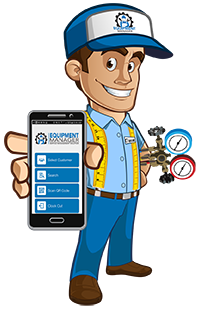Equipment Manager is designed to help make managing Building Mechanical Equipment easier. At the current time, this includes HVAC and Building Service Equipment like Fire Extinguishers, Sinks, and Exit Signs. Equipment Manager is designed to be used in two deciding factors, the Contractor, and the Owner/Property Manager. Both factors have very different outlooks on the process, but utilize the same basic elements.
With Equipment Manager, the system is comprised of five basic elements:
With Equipment Manager, the system is comprised of five basic elements:
- The Client - Person or organization responsible for paying invoices.
- The Customer - Owner or Property Manager who owns buildings (known as Job Sites)
- The Job Site - Single physical structure where Equipment is located.
- The Equipment - Items installed at Job Sites being tracked and serviced.
- The Technician - The Technician preforms the work that ties all these elements together.

The Two Factors of Equipment Manager.
As stated there are two factors that currently make up Equipment Manager. One is the Customer, the other is the Contractor. Everything that makes up Equipment Manager revolves around these two elements. Both have separate screens that they can see when logged into Equipment Manager portal.Benefits of the Customer.
The Property Owner is designated the Customer in Equipment Manager. The software allows the Customer to request service and view the results of Inspections, Evaluations, and Service Reports. Customers can add Job Sites, Suites and make Service Requests as needed. Customers can also create Guest Contractors and Technicians as needed and assign service requests to be completed using our Guest Technician app. The Guest Technician is a single user that has mobile access to view Equipment information and request service from any assigned Guest Contractor.With Equipment Manager, this is all as simple as scan and click. Customer users can also create Lock Out Tag Out procedures that must be followed by the responding Tech. This along with the ability to store digital information such as manuals, images, and text about any piece of Equipment makes Equipment Manager a great tool.


